Finding the perfect studio microphone isn’t just a choice. It’s a vibe. The right mic brings out character, warmth, and power in a vocal take. Some models truly shine with pop and rock genres, handling both grit and clarity like pros. While others are great when it’s a soft ballad or a bold anthem. Legends like the Neumann TLM 102 and AKG C414 XLII get a lot of love, but there are plenty of hidden gems too.
This guide explores top picks, compares features, and highlights what real artists think so you’re ready to hit record.
Why Trust Us?
As the official blog of Hollyland—an industry-leading brand in wireless audio—we combine insights from our engineers, audio experts, and real creators. Our recommendations are based on lab tests, hands-on use, and objective comparisons with other top brands, ensuring reliable and honest advice for users.
Top Picks at a Glance
| Model | Type | Frequency Response | Phantom Power Required | Best For | Price |
| Neumann TLM 102 | Condenser | 20Hz – 20kHz | Yes (48V) | Crisp, top-end audio | $713.55 |
| Shure SM57 | Dynamic | 40Hz – 15kHz | No | Vocals and instruments | $109 |
| RODE M5 | Condenser | 20Hz – 20kHz | Yes (P24 and P48) | Stereo miking | $177.90 |
| AKG C414 XLII | Condenser | 20Hz – 20kHz | Yes (48V) | Bright vocals | $1118.99 |
| Electro-Voice RE20 | Dynamic | 45Hz – 18kHz | No | Radio tone | $449 |
| Shure SM7dB | Dynamic | 50Hz – 20kHz | No | Uncolored sound | $549 |
| Sennheiser MD421 | Dynamic | 30Hz – 17kHz | No | Soft vocal edges | $349 |
| RODE NT1 5th Generation | Condenser | 20Hz – 20kHz | Yes (48V when used with XLR) | Rich vocals | $249 |
| Shure SM7B | Dynamic | 50Hz – 20kHz | No | Noise isolation | $439 |
| AKG C214 | Condenser | 20Hz – 20kHz | Yes (48V) | Vocal clarity | $369.07 |
| Aston Microphones Origin | Condenser | 20Hz – 20kHz | Yes (48V) | Authentic midrange | $197.50 |
| Shure SM58 | Dynamic | 50Hz – 15kHz | No | Focused vocals | $109 |
| RODE NT1 | Condenser | 20Hz – 20kHz | Yes (P24 and P48) | Precision | $249 |
| Shure SM4 | Condenser | 20Hz – 20kHz | Yes (48V) | Home recording | $219 |
| FIFINE K688 | Dynamic | 50Hz – 15kHz | No | Budget-friendly | $51.09 |
NOTE: Prices are sourced from Amazon (US) and are subject to change over time.
Best Studio Microphones: Detailed Reviews
1. Neumann TLM 102 – Powerhouse for Project and Home Studios

Neumann TLM 102 is a large diaphragm condenser mic with a rich tone. The transformerless circuitry handles high SPLs without any distortion. Great for loud vocals or drums in tight spaces. The integrated pop screen controls harsh bursts in speech or singing. No extra accessory needed. The bass feels tight and warm. Highs sound silky and clear. The body is short, solid, and built to last.
Specifications:
Polar pattern: Cardioid
Frequency response: 20Hz – 20kHz
Connector: XLR 3-Pin Male
Sensitivity: 11 mV/Pa
Max SPL: 144 dB (0.5% THD)
Self-noise (Equivalent Noise Level): 21 dB (CCIR) / 12 dB (A-weighted)
Pros:
- Warm and clear vocal tone
- Compact but studio-quality sound
- Solid and premium build
- Great for drums, bass, and vocals
- Easy to use for home studios
Cons:
- Sound can feel flat for trained ears
- Lacks detail with some instruments
Suitable for: Home-based recordings, vocalists, podcasters, voice actors, musicians, streamers, and producers
Real review from Reddit: “This mic has a full, rich and smooth sounding bottom which can be pleasing on lower voice ranges, and the upper end boost is quite high and beyond the sibilance range for many.” — @dwpthe3rd
Price: $713.55
2. Shure SM57 – Clean Sound, Rock-Solid Build
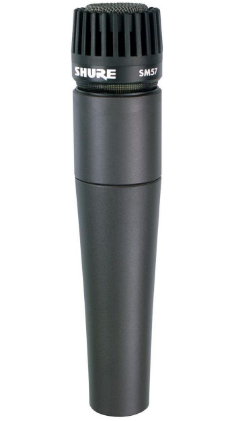
The Shure SM57 knows how to keep it clean and tight. Its contoured frequency response makes vocals sound full without being harsh. Guitars and drums come out crisp and natural. No weird tones, just honest sound. The frequency response attenuates sub‑bass, so the lows stay clean. That’s super helpful when amps and live instruments get muddy. The extremely durable build handles heavy use like a champ. No fear of dents or drops here.
Specifications:
Polar pattern: Cardioid
Frequency response: 40Hz – 15kHz
Connector: 3-pin XLR
Sensitivity: -56 dBV/Pa (1.6 mV/Pa)
Max SPL: Not specified
Self-noise (Equivalent Noise Level): N/A
Pros:
- Great all-rounder for instruments and vocals
- Very affordable for most users
- Super durable and long-lasting
- Widely used even in pro studios
Cons:
- Needs a strong preamp for quiet sources
- Limited sensitivity for softer performances
- Can sound dull without proper EQ
Suitable for: Studio recording, live sound, guitar amps, podcasting, spoken word, and streaming
Real review from Reddit: “SM57 was my first mic, too! And I still have mine. It’s the best first choice because they’re cheap, they’re virtually indestructible, and you can mic anything with them.” — @ThatlldoNZ
Price: $109
3. RODE M5 – Smooth Stereo, Subtle Sparkle

The M5 matched pair from RODE captures sound with care. The carefully selected pair has less than 1dB sensitivity difference. That means smooth stereo without harsh shifts or drops. Its sound is neutral-toned, with detail and a subtle presence boost. The low-end feels slightly thin, which helps avoid muddiness. However, the capsule is not interchangeable, and there’s no onboard pad or high-pass filter.
Specifications:
Polar pattern: Cardioid
Frequency response: 20Hz – 20kHz
Connector: XLR (Balanced output between pin 2 [+], pin 3 [-], pin 1 [ground])
Sensitivity: -34 dB re 1V/Pa (20mV @ 94 dB SPL) ± 2dB @ 1kHz
Max SPL: 140 dB SPL
Self-noise (Equivalent Noise Level): 19 dBA SPL (as per IEC651)
Pros:
- Durable and solid build
- Great stereo imaging when placed right
- Low self-noise and clean signal
- Easy to travel with
Cons:
- Can sound thin or bright without EQ
- Very sensitive to wind and plosives
- Needs careful placement for best sound
Suitable for: Home studios, choir recordings, acoustic instruments, school events, piano sessions, and budget-conscious musicians
Real review from Amazon: “Absolutely fantastic value for money. Clarity and presence – if anything, just a little top-y which can be easily sorted with a hint of EQ.” — @Alex Turner
Price: $177.90
4. AKG C414 XLII – Pro Studio Sound with Stunning Detail

The AKG C414 XLII makes vocals sound alive. It lets you experience bright highs with a smooth edge on vocals. Also, the acoustic guitars come through with detail and warmth. The 9 switchable polar patterns adjust easily for solo tracks or full-room setups. The switchable pad at -6, -12, or -18 dB keeps loud sources under control. It feels solid in hand, but the capsule and grille are delicate, so handle with care.
Specifications:
Polar pattern: Cardioid, Figure 8, Hypercardioid, Omnidirectional, Wide Cardioid
Frequency response: 20Hz – 20kHz
Connector: Balanced 3-pin Male XLR
Sensitivity: 23 mV/Pa
Max SPL: 158 dB
Self-noise (Equivalent Noise Level): 6 dB-A
Pros:
- Durable build despite light drops
- Low self-noise for clean recordings
- Professional studio-level quality
Cons:
- Picks up unwanted background noise without treatment
- Susceptible to plosives without a pop filter
- May sound sibilant or too bright for some voices
Suitable for: Studio vocals, acoustic instruments, voiceovers, podcasting, sound engineers, and audiophiles
Real review from Amazon: “This mic has amazing specs and an unbelievable choice of 9 input settings. Even the packaging, pop filter and shock mount are high class.” — @Jason Steen
Price: $1118.99
5. Electro-Voice RE20 – Warm, Classic FM Voice

Famous for its FM-radio vibe, the Electro-Voice RE20 nails that deep voice feel. The Mid-bass tone-shaping switch helps smooth out boxy mids, great for voiceovers or live talk. Thanks to Variable-D for minimal proximity effect, there’s no sudden boom when leaning closer. It sounds full yet neutral, never harsh or flat. The heavy-duty internal pop filter tackles plosives with ease, even in tight mic positions.
Specifications:
Polar pattern: Cardioid
Frequency response: 45Hz – 18kHz
Connector: XLR
Sensitivity: 1.5 mV/Pa at 1 kHz
Max SPL: Not specified
Self-noise (Equivalent Noise Level): N/A
Pros:
- Excellent at rejecting background noise
- Handles vocals and instruments equally well
- Strong build with pro-level durability
- No need for external EQ for voice clarity
- Crisp “S” sounds with no harshness
Cons:
- Requires a lot of gain
- Heavy and not travel-friendly
Suitable for: Broadcasting, podcasting, voiceover artists, musicians, radio hosts, streamers, and vocal engineers
Real review from Amazon: “It’s a wonderful professional microphone. Every radio station I’ve ever worked for in my career has this same microphone and that’s why I chose it as well.” — @Sherry
Price: $449
6. Shure SM7dB – Sound Natural without Cloudfilter
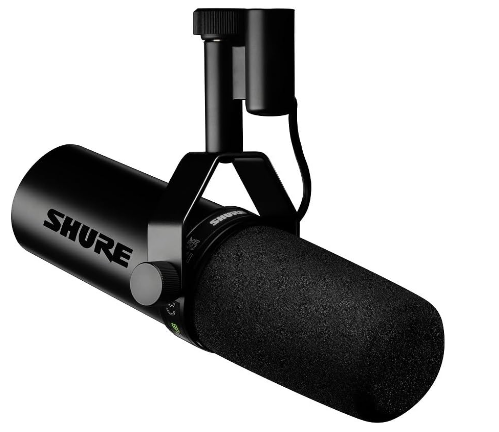
The Shure SM7dB is a dynamic mic with a clear focus. Its built-in preamp gives either +18dB or +28dB of clean gain, making low-output setups feel powerful. The yoke mounting with captive stand nut keeps positioning easy and steady. Sound stays dry, catching voice upfront and rejecting room echo. The heavy-duty design still feels friendly to use.
Specifications:
Polar pattern: Cardioid
Frequency response: 50Hz – 20kHz
Connector: 3-pin XLR
Sensitivity: On Bypass mode: -59 dBV/Pa, On +18 dB preamp mode: -41 dBV/Pa, On +28 dB preamp mode: -31 dBV/Pa
Max SPL: Not specified
Self-noise (Equivalent Noise Level): N/A
Pros:
- Excellent noise rejection
- Rugged and durable build
- Easy to mount and position
- Handles untreated rooms well
Cons:
- Needs time and knowledge to set up properly
- Built-in windscreen not enough for plosives
Suitable for: Podcasting, voiceover artists, home studio setups, streaming, singing, and broadcasting
Real review from Amazon: “I had this mic for more than 4 months now and its amazing. No wall acoustics needed. I purchased the Shure mic stand too. It holds up perfectly. Would most definitely recommend.” — @Cosmo
Price: $549
7. Sennheiser MD 421-II – Warm Sound with Solid Protection
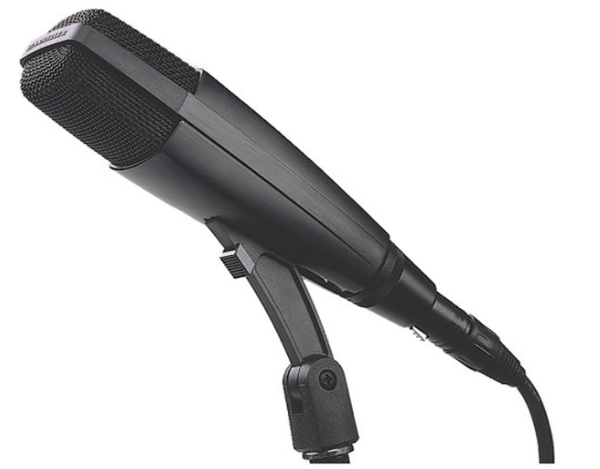
The Sennheiser MD 421-II handles low-end buildup with ease. Its five position bass roll-off switch keeps close vocals from sounding muddy. The full-bodied cardioid pattern keeps background noise under control for focused takes. There’s a gentle smoothness to its tone as the natural compression and slower transient response round off harsh edges.
Specifications:
Polar pattern: Cardioid
Frequency response: 30Hz – 17kHz
Connector: 3-pin XLR
Sensitivity: Not specified
Max SPL: Not specified
Self-noise (Equivalent Noise Level): N/A
Pros:
- Handles high SPL without distortion
- Cardioid pattern offers a forgiving sweet spot
- Excellent build quality and long-lasting design
Cons:
- Sharp highs may require post-EQ or off-axis positioning
- Plosives can be an issue without a pop filter
- Mic is bulky and can be tricky to place in tight spots
Suitable for: Studio engineers, podcasters, drummers, radio hosts, voice actors, guitarists, and vocalists
Real review from Amazon: “One of the great workhorses of the home studio and everywhere else.” — @Samuel Mendales
Price: $349
8. RODE NT1 5th Generation – Captures Various Pitches Without A Sweat

The RODE NT1 5th Generation keeps things silky, warm, and crisp. That dreamy sound hugs vocals like velvet. Thanks to low self-noise, quiet parts feel whisper-clean. Then comes the 32-bit float recording. With dual connect output, this Rode flips between XLR and USB without complaining. The built-in digital signal processing adds a clever touch, great for quick fixes or polish.
Specifications:
Polar pattern: Cardioid
Frequency response: 20Hz – 20kHz
Connector: 3-pin XLR
Sensitivity: -32 dB re 1 Volt/Pascal (25 mV @ 94 dB SPL) +/- 2 dB @ 1 kHz
Max SPL: 142 dB
Self-noise (Equivalent Noise Level): 4 dBA
Pros:
- Warm and detailed sound for voice
- USB and XLR ports offer a flexible setup
- Internal FX can clean up some background noise
Cons:
- Picks up keyboard and mouse clicks easily
- Noise gates may not fully block loud background sounds
- May sound too bassy if placed too close
Suitable for: Music recording, podcasting, voice-over artists, streamers, dubbing work, video creators, and hybrid studio users
Real review from Reddit: “That’s a great mic that can easily last your whole career!” — @Boring_Collection662
Price: $249
9. Shure SM7B – Sounds Like Butter, Bites Like a Beast
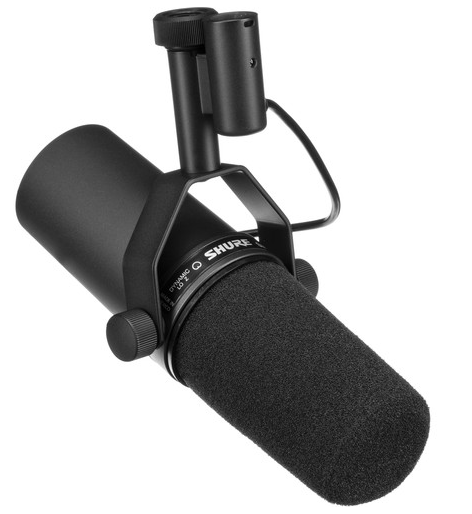
The Shure SM7B uses a cardioid polar pattern to catch only the voice and block the rest. With bass roll-off and presence boost, vocals sound full and crisp. Its broadband interference shielding stops unwanted noise. It gives a warm, natural, and smooth tone with great off-axis rejection. It does need EQ and gain, but overall, it sounds rich. Moreover, it also works great on electric guitars.
Specifications:
Polar pattern: Cardioid
Frequency response: 50Hz – 20kHz
Connector: 3-pin XLR
Sensitivity: -59 dBV/Pa (1.12 mV/Pa)
Max SPL: Not specified
Self-noise (Equivalent Noise Level): Not specified
Pros:
- Built-in air suspension reduces desk bumps
- Maintains vocal fidelity accurately
Cons:
- Requires extra gear like Cloudlifter
- Needs a lot of gain to sound loud enough
Suitable for: Studio vocals, podcast hosts, voice-over artists, musicians, streamers, and broadcasters
Real review from Amazon: “Whether I’m recording vocals for music, podcasts, or voiceovers, it captures the nuances and richness of my voice with remarkable clarity.” — @Adam Nelson
Price: $439
10. AKG C214 – Clarity That Cuts Through Every Mix
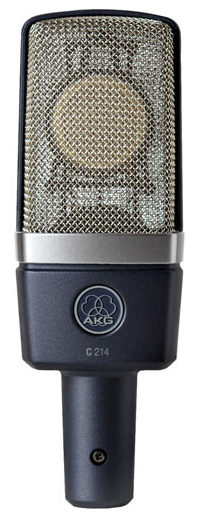
The AKG C214 uses the same 1-inch capsule as the C414 but sticks to a single-diaphragm design. It sounds clear, full, and nicely presence-lifted. Vocals feel alive and guitars hit just right. The -20 dB pad helps when recording loud drums or amps. With the 160 Hz low-cut filter, room rumble stays out. It handles 156 dB SPL, so distortion isn’t a problem.
Specifications:
Polar pattern: Cardioid
Frequency response: 20Hz – 20kHz
Connector: Balanced XLR, 3-pin male
Sensitivity: 20 mV/Pa
Max SPL: 156 dB (with -20 dB pad engaged)
Self-noise (Equivalent Noise Level): 13 dB-A
Pros:
- Handles group and solo recordings well
- Crisp highs with warm low-end
- Reliable for acoustic instruments
- Good value in its price range
Cons:
- Too bright for deep voice-over work
- Can clip with loud or strong vocals
Suitable for: Rap vocals, group performances, male singers, podcasting, acoustic instruments, and home studio recording
Real review from Amazon: “Pure sound reproduction, nice and flat. I have a lot of bass tones in my voice; the low end roll-off is a perfect balance.” — @Steve
Price: $369.07
11. Aston Microphones Origin – Clean Highs, Smooth Mids, Strong Presence
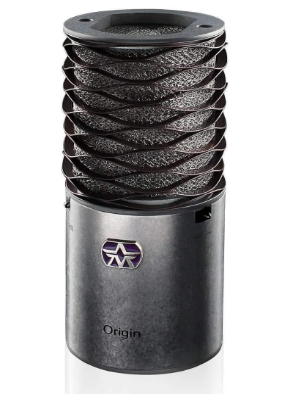
The Aston Microphones Origin feels like a clever blend of style and function. Its custom molded end caps hold the XLR snug while the universal stand thread adapter makes setup feel effortless. Now here’s the fun! The wave-form spring head doesn’t just look cool. It actually protects the capsule like a mini shock guard.
Specifications:
Polar pattern: Cardioid
Frequency response: 20Hz – 20kHz
Connector: XLR
Sensitivity: 23.7mV/Pa at 1kHz into 1k Ohm
Max SPL: 127dB (for 0.5% THD)
Self-noise (Equivalent Noise Level): 18dB A-Weighted
Pros:
- Very detailed and smooth highs
- Built-in pad and filter switches
- Solid, heavy-duty metal build
- Easy to use with Pro Tools
Cons:
- Hard to find a shock mount that fits
Suitable for: Studio vocals, singer-songwriters, acoustic recordings, engineers, YouTube covers, instrument tracking, and podcasting
Real review from Amazon: “It blows most mics, for sure all the ones in this price range, out of the water! Nice high end, clear, clean, and I don’t have to boost the gain.” — @Amazon Customer
Price: $197.50
12. Shure SM58 – Built for Vocals
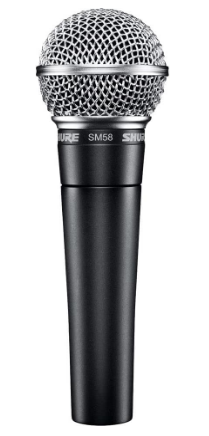
The Shure SM58 is made for vocals that hit right. Its ball grille with built-in pop filter keeps harsh plosives out. Vocals sound smooth without those annoying bursts of air. The stand adapter is break-resistant and rotates 180 degrees, so setups feel easy. Plus, its rugged body fights off handling noise and feedback like a pro.
Specifications:
Polar pattern: Cardioid
Frequency response: 50Hz – 15kHz
Connector: 3-pin XLR
Sensitivity: -54.5 dBV/Pa (1.6 mV/Pa)
Max SPL: Not specified
Self-noise (Equivalent Noise Level): N/A
Pros:
- Great sound quality for live vocals
- No latency issues
- Handles feedback well
- Comfortable to hold
Cons:
- A bit quiet without a preamp
- Sound can feel slightly bright to some users
Suitable for: Live performers, studio vocalists, karaoke setups, podcasters, and musicians
Real review from Amazon: “This mic is amazing for live vocals and there is a reason it is still an industry standard till this day. If you are a performer/musician this is an absolute must in your arsenal!” — @James Rice
Price: $109
13. RODE NT1 – Smooth Sound That Still Wins Hearts
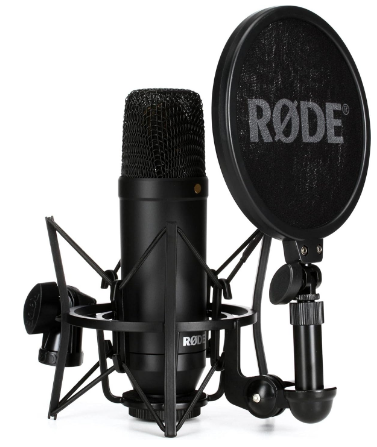
The RODE NT1 came before the NT1 5th Generation. Even now, many users still prefer this classic gem. Its large-diaphragm 1-inch gold-sputtered capsule makes lows sound rich. But guess what? It prevents the voice from getting muddy. Besides, the mids come out clear, great for natural vocals. The solid aluminium body adds a strong feel with lasting strength.
Specifications:
Polar pattern: Cardioid
Frequency response: 20Hz – 20kHz
Connector: XLR
Sensitivity: -29.0dB re 1V/Pa (35.00mV @ 94dB SPL) ±2dB @ 1kHz
Max SPL: 132dB SPL
Self-noise (Equivalent Noise Level): 4.5dBA
Pros:
- High-quality included a shock mount and pop filter
- Easy setup with standard XLR connection
Cons:
- Not ideal for untreated or echoey rooms
- Included shock mount can be hard to adjust
Suitable for: Voiceover artists, audio engineers, podcasters, home studios, vocalists, and acoustic guitar recordings
Real review from Amazon: “NT1 delivers a professional, polished sound with minimal need for post-processing.” — @frostbite
Price: $249
14. Shure SM4 – Naturally Detailed Audio for Home Recordings
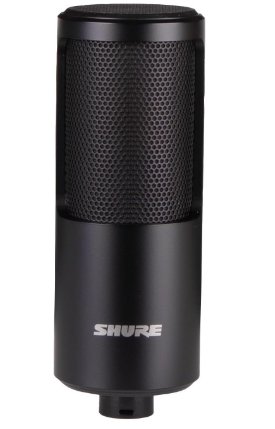
The Shure SM4 locks onto sound with confidence. Its brass 1-inch dual-diaphragm capsule captures low-end that feels full but never muddy. Highs come through with a silky smoothness that feels effortless. No sharp spikes or weird dips. Everything sounds clean and natural. Thanks to Patent-Pending Interference Shielding Technology, there’s no buzzing from phones or Wi-Fi. Just pure signal, no distractions.
Specifications:
Polar pattern: Cardioid
Frequency response: 20Hz – 20kHz
Connector: XLR 3-Pin Male
Sensitivity: -38 dBV/Pa
Max SPL: 140 dB – 145 dB
Self-noise (Equivalent Noise Level): Not specified
Pros:
- Very low plosives without a pop filter
- Sturdy all-metal build
- High sensitivity and clarity
- Requires little post-processing
Cons:
- Harsh plosives may still pass through
- Vibration can cause slight handling noise
- No onboard controls or pads
Suitable for: home studio recording, podcasting, vocal tracking, instrument capture, and content creation
Real review from Amazon: “İ really liked this mic! was honestly a little hesitant but I’m glad I bought it. Very balanced.” — @livia hastoprak
Price: $219
15. FIFINE K688 – Bold Sound in a Pocket-Friendly Price
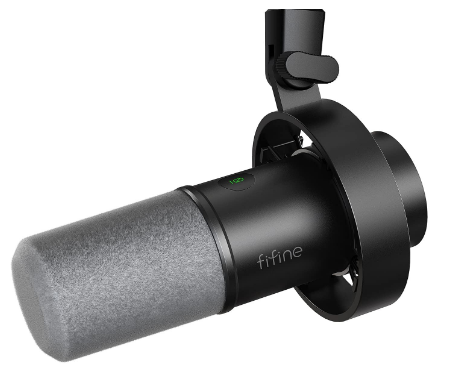
The FIFINE K688 adapts quickly with both USB and XLR. Start clean with USB. Switch to XLR when the setup gets serious. This dynamic mic handles noisy rooms without a hitch. It also features a fast touch-mute for instant quiet. With live monitoring, nothing slips past your ears. Additionally, the I/O level controls help shape your sound with ease.
Specifications:
Polar pattern: Cardioid
Frequency response: 50Hz – 15kHz
Connector: XLR / USB Type-C to Type-A 2.0
Sensitivity: -58 +/- 3 dB
Max SPL: 130 dB
Self-noise (Equivalent Noise Level): Not specified
Pros:
- Performs better than some higher-priced mics
- Solid build and professional appearance
- Good shock mount included
- Long USB cable with Velcro straps
Cons:
- Mute button may fall out over time
- Mic cover is too thin, allows breath noise
- Picks up desk and boom arm vibrations
Suitable for: podcasting, voice-over recording, streaming setups, vocal tracking, and gaming use
Real review from Amazon: “This mic makes me sound amazing and it looks amazing on my setup” — @obed davila
Price: $51.09
BONUS RECOMMENDATION: Hollyland LARK MAX 2 – Capture Perfection with 32-Bit Float and Real-Time Monitoring

The Hollyland LARK MAX 2 isn’t built for studios, yet it sounds rich and noise-free. Its wireless lapel design feels modern and practical. The 32-bit float internal recording keeps every tiny detail safe, even during loud moments. Besides, the OWS Bluetooth earphones offer live monitoring, so no recording feels like guesswork.
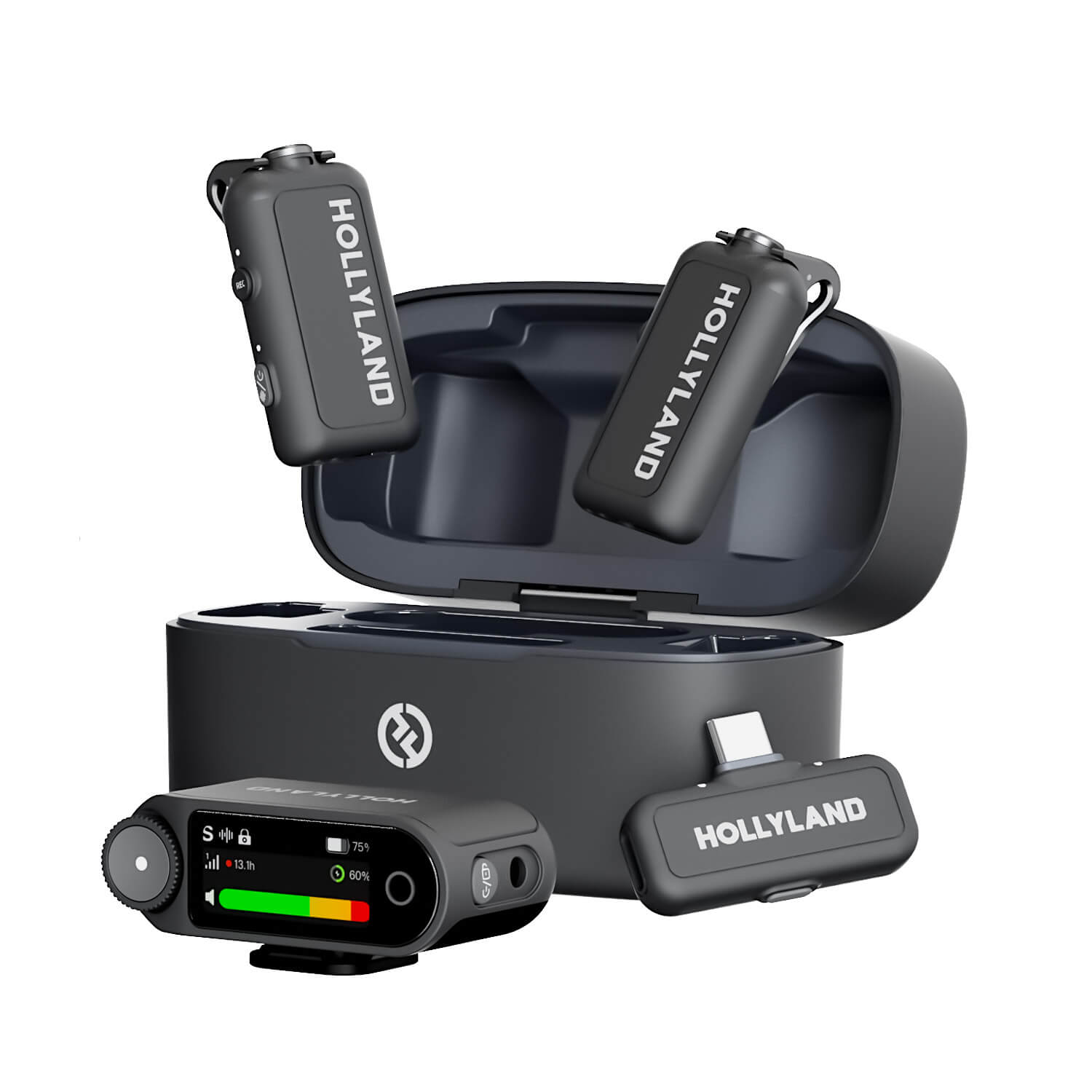
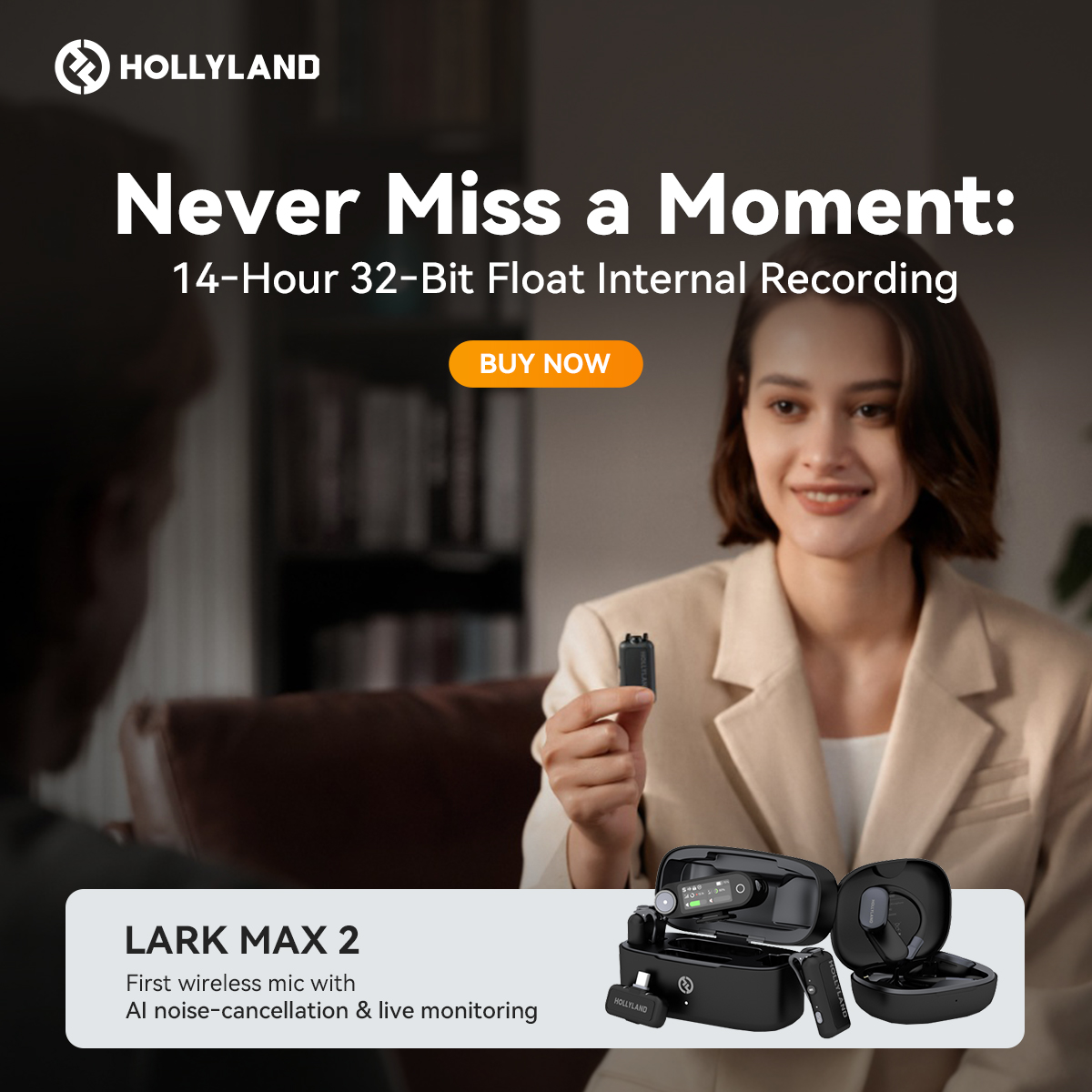
Hollyland LARK MAX 2 - Premium Wireless Microphone System
A premium wireless microphone for videographers, podcasters, and content creators to capture broadcast-quality sound.
Key Features: Wireless Audio Monitoring | 32-bit Float | Timecode
Read full Hollyland LARK MAX 2 review for more details.
Specifications:
Polar pattern: Omnidirectional
Frequency response: 20Hz – 20kHz
Connector: USB-C (3.5mm TRS and UAC via adapter)
Sensitivity: -37 dBV +/- 2 dBV @1 kHz, 94 dB SPL
Max SPL: 128 dB
Battery life (TX): 11 hours
Pros:
- Wireless range up to 340m
- Comes with many accessories
- Easy-to-use touch controls on the receiver
- Receiver mounts forward and backward
- Supports OWS monitoring and AirPods simultaneously
Cons:
- Wireless monitoring is not supported in 4TX & 1RX mode
Suitable for: Vlogging, smartphone and camera users, sports instructors, filmmakers, interviewers, teachers, YouTubers, and content creators
Real review from Amazon: “These bad boys sound good out of the box! They feel premium and the transmitters are super light weight at 14g! You get so many accessories!!” — @Robert R Clark JR
Price: $279
Conclusion
Neumann TLM 102, AKG C414 XLII, and RODE NT1 5th Generation are known for great studio results. On a smaller budget, Shure SM57 and SM58 still impress. When C414 XLII feels pricey, AKG C214 makes a solid pick. But we have listed many more studio microphones for every setup. Just take your pick and start recording.
FAQs
Q1. What is the difference between a live microphone and a studio microphone?
There’s a real difference between live and studio mics. Live mics like dynamics are tough and can handle loud sound without breaking a sweat. Perfect when there’s shouting or noise all around. Studio mics, usually condensers, are super sensitive. They catch tiny sound details that live mics would miss. Great for quiet rooms where every little whisper counts. Both feel like totally different beasts.
Q2. What type of mic is the best for a studio?
Studio recording has its own mic favorites. Condenser mics win here because they pick up every fine sound. Vocals and acoustic guitars sound extra rich with them. Dynamics work better in loud rooms or performances. Ribbon mics are smooth with high frequencies, perfect for warmth and softness in recordings. Choosing depends on the sound being captured and the space around.
Q3. Why are studio microphones so expensive?
Studio mics aren’t cheap, and there’s a reason. They’re made with precision parts, high-end materials, and loads of care. That quality boosts sound clarity and makes the mic last longer. Every part is there for a reason, and nothing feels random. It’s why studios spend extra, especially when audio quality is top priority. Not just for the fancy label.
Q4. What is the thing in front of a mic in a studio?
That round object in front of a mic is a pop filter. It blocks strong air bursts when someone says words with p or b. These bursts can mess up a recording. The filter is usually a thin mesh or metal stretched on a ring. It quietly saves the tone from sounding rough or harsh. Simple but very useful in vocal sessions.
Q5. Is a condenser mic good for singing in a studio?
Condenser mics are a dream for vocal sessions in studios. They hear things regular mics miss and make the voice sound clear. Every tiny tone, every little breath gets recorded. But yes, they catch background noise easily, so silence helps. They also need phantom power, which most audio interfaces provide. Still, their sound quality is completely worth it.

































.png)




